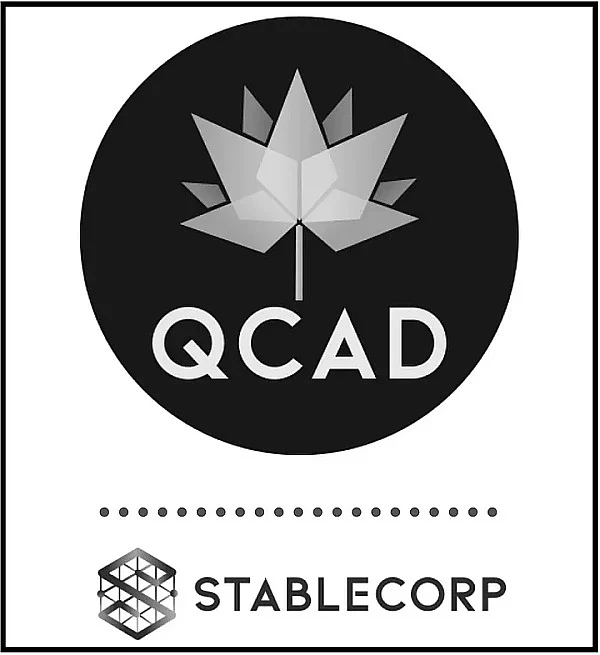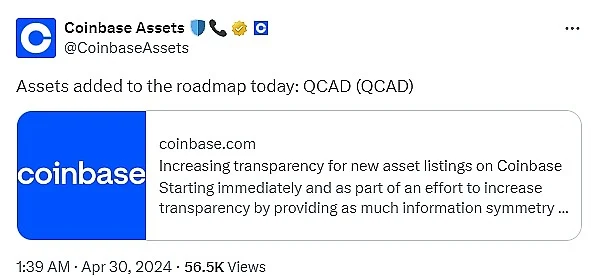Canada has launched the stablecoin QCAD, with strong support from Coinbase
In the competitive cryptocurrency market, the stablecoin QCAD has quickly gained prominence. On April 30th, Coinbase Assets announced the addition of QCAD to its listing roadmap, significantly boosting QCAD’s market position.
Issued by Canada Stablecorp, a joint venture between cryptocurrency asset management company 3iQ and blockchain development company Mavennet Systems, QCAD has been available since 2020 through partners like DVeX and Newton, supporting trading pairs with BTC, ETH, and USDC. Maintaining a 1:1 value ratio with the Canadian dollar, QCAD ensures its stability through reserves of cash and equivalents.
In the stablecoin market, QCAD’s stability and reliability make it a noteworthy option. Below, we’ll explore QCAD’s core advantages and its role in the global crypto economy.
Trading Volume and Supply of Stablecoins
Recent performance in the stablecoin market is notable, especially against the backdrop of fluctuations in total cryptocurrency market capitalization. In April 2024, both the trading volume and supply of stablecoins showed significant growth trends, despite an overall crypto market downturn. According to the latest market data, stablecoins, particularly DAI, USDT, and USDC, have seen increased activity in recent months, reflecting a sustained demand for stable assets.

USDT and USDC, as leading stablecoins in the market, have continued to grow their supply, indicating steady capital inflows into the crypto market. Additionally, stablecoin trading volume reached new highs in April, partly due to the widespread use of stablecoins in cryptocurrency trading platforms and financial technology applications.
The high demand for stablecoins in the market partly stems from their function as bridges between liquidity and stability in the crypto market. In uncertain market conditions, investors and traders tend to use stablecoins to protect asset values and mitigate risks associated with price fluctuations. Furthermore, stablecoins’ applications in the decentralized finance (DeFi) space continue to expand, further bolstering their market position.
Despite downward pressure on the market, stablecoins remain resilient, demonstrating their core position in the cryptocurrency ecosystem.
Applications and Core Elements of QCAD
QCAD, as the first fully regulated Canadian stablecoin, aims to provide a stable digital “Canadian dollar” solution to the wider market. This section will delve into the workings of QCAD, mechanisms for maintaining stability, and its diverse application scenarios.
Stability and Compliance Analysis:
QCAD’s primary mechanism for maintaining its value at one Canadian dollar (1 CAD) is through authorized dealers’ buy and sell operations. Authorized dealers can buy or sell QCAD from Stablecorp Digital Currencies Inc. at a price of 1 CAD. This mechanism ensures that if QCAD’s market price deviates from 1 CAD, arbitrage opportunities will adjust the price back to 1 CAD.
To enhance market confidence in authorized dealers’ ability to continuously buy and sell QCAD, Stablecorp provides monthly statements and annual audits of QCAD reserves. Additionally, Stablecorp has established extensive compliance and governance infrastructure to ensure that QCAD is always backed by cash or equivalent assets held by a custodian at a 1:1 (or higher) ratio.
Introduction to QCAD’s Application Scenarios:
QCAD serves not only as a payment method but also facilitates the trading, lending, and borrowing of crypto assets on multiple blockchain platforms such as Ethereum, Algorand, and Stellar. Other applications of QCAD include: serving as an on-chain forex solution, facilitating digital-to-digital currency trades, especially with connections to the Circle and USDC ecosystems; serving as a fast and cost-effective domestic and international transfer/payment channel within Canada; and serving as an instant Canadian dollar-denominated bridge asset between crypto assets and fiat.
All QCAD transactions are securely recorded on the blockchain, ensuring immutability, transparency, and auditability, enabling seamless settlements and complete traceability.
Purchase Channels and Financial Reserves:
QCAD tokens can be purchased through institutions known as “authorized dealers,” which undergo rigorous customer onboarding and anti-money laundering/customer identification checks. The legal currency reserves for QCAD are custodied by Tetra Trust Company, which maintains specialized “trust accounts” at Canadian financial institutions to segregate QCAD reserves. These legal currency reserves are kept separate from Stablecorp’s other assets, with Stablecorp’s role limited to operating QCAD and managing these legal currency reserves.
Through these measures, QCAD not only provides a stable Canadian dollar digital asset but also brings innovative payment and trading solutions to the cryptocurrency market, bridging the gap between crypto assets and the traditional financial system.

Tracing Development History of QCAD
On February 11, 2020, Canada Stablecorp Inc. announced the launch of the Canadian dollar stablecoin “QCAD,” marking a significant development in the Canadian digital asset market. QCAD is now available through ecosystem partners such as DVeX, Newton, Bitvo, Netcoins, and Coinsmart, supporting trading pairs with major cryptocurrencies like Bitcoin, Ethereum, and USDC. Backed by cryptocurrency custodians Balance and Bitgo, QCAD operates as an ERC-20 standard digital asset on the Ethereum blockchain, ensuring seamless settlements and full traceability, with plans to expand to other networks in the future.
As the market’s first fully regulated Canadian dollar stablecoin designed for the mass market, QCAD’s launch has played a crucial role in driving Canada’s capital markets towards digital transformation and providing robust payment and settlement solutions. Jean Desgagne, CEO of Canada Stablecorp, stated that QCAD provides a new financial infrastructure for the market and sets a new standard for digital currencies, which helps build trust and widespread adoption of stablecoins.
The digital asset market has traditionally been known for its high volatility, and stablecoins serve as a key bridge between traditional financial infrastructure and the native digital world. The market size of stablecoins has rapidly expanded in recent years, from $24 billion in 2018 to over $49.4 billion in 2019.
Furthermore, Kesem Frank, President of Mavennet Systems, emphasized that QCAD establishes necessary connections between the Canadian financial market and the digital asset world. Fred Pye, President and CEO of 3iQ Corp, believes that QCAD’s launch is a logical step for Canada’s capital markets towards a digital future, with QCAD playing a crucial settlement role.
In summary, QCAD’s launch not only enhances Canada’s competitiveness in the global financial market but also lays a solid foundation for the widespread acceptance and application of digital currencies.
QCAD Stablecorp to Receive Strong Support from Coinbase
Stablecorp, a joint venture between Canada’s largest cryptocurrency asset management company 3iQ and blockchain development leader Mavennet Systems, has successfully launched the Canadian dollar stablecoin QCAD. As the first fully compliant Canadian dollar stablecoin designed for the mass market, QCAD represents both technological innovation and market responsiveness to the demand for stability and compliance.
The leadership team comprises industry experts, including CEO Alex McDougall, COO Julie Paterson, Chief Compliance Officer Paul Burak, and Board Chairman Jean Desgagne, whose collaborative efforts ensure strategic execution and market promotion of QCAD. Additionally, experts from various fields such as legal advisor Ross McKee and fintech developer Eugene
Tay provide solid support for QCAD’s robust operation and compliance.

Recently, Coinbase Assets announced the addition of QCAD to its listing roadmap on the X platform, indicating further expansion of QCAD’s market acceptance and application prospects. This decision not only enhances QCAD’s liquidity but also provides Canadian and global investors with more trading and investment choices.
Bottom Line
As the digital asset market continues to mature, QCAD’s compliance and stability characteristics may attract more users and institutions seeking hedging and trading efficiency. However, as an innovative digital asset, QCAD still needs to prove its continued value and utility in future markets. Whether it can maintain its leading position in the increasingly competitive stablecoin market remains to be further tested by the market.
How will QCAD’s future unfold, and how will the market respond to this Canadian innovative digital solution?